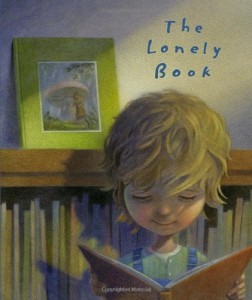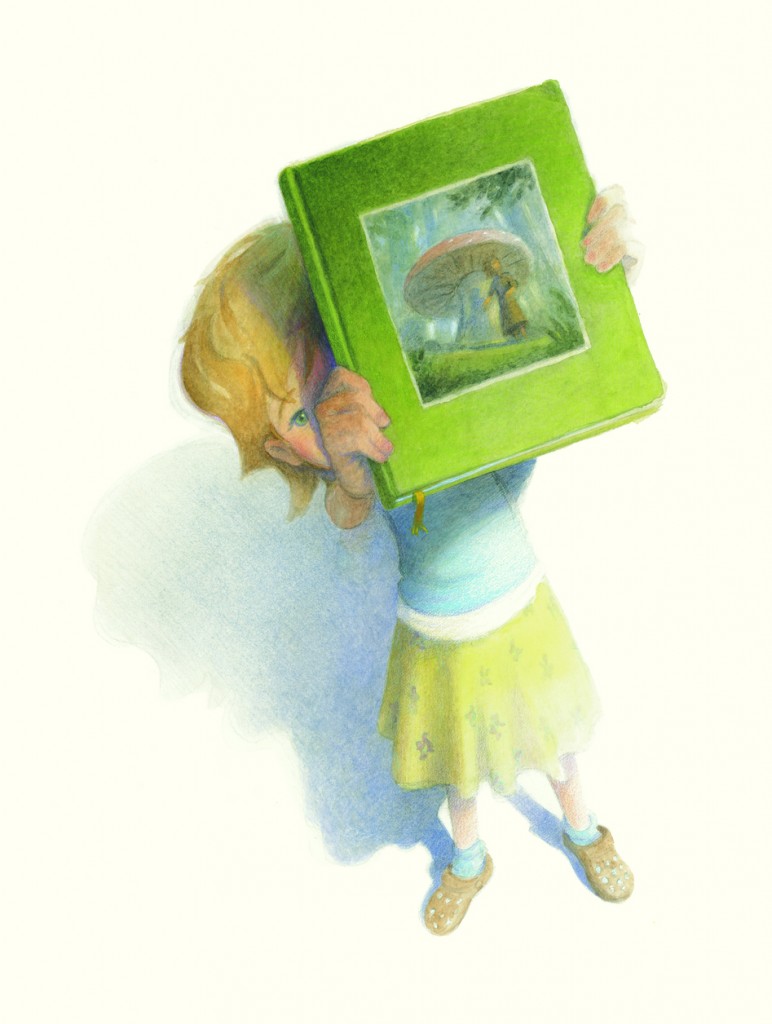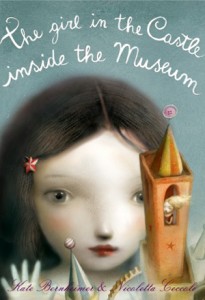By Nicki Richesin, The Children’s Book Review
Published: April 23, 2012

Kate Bernheimer first enchanted children with her captivating The Girl in the Castle inside the Museum. Her latest The Lonely Book is yet another heartfelt addition to her mesmerizing picture books. Kate’s forthcoming children’s book The Girl Who Wouldn’t Brush Her Hair is being illustrated this spring. She is also the author of fiction for adults, including a trilogy of novels and the story collection Horse, Flower, Bird (Coffee House Press). Kate is founder and editor of Fairy Tale Review, and of three fairy-tale anthologies including the World Fantasy Award winning My Mother She Killed Me, My Father He Ate Me: Forty New Fairy Tales (Penguin Books). She has spoken on fairy tales as a contemporary art form at such venues as the Museum of Modern Art, the Chicago Public Library, the Boston Public Library, The Walker Art Center, Ball State University Museum of Art, and Harvard University. We’re delighted to share a conversation about her books, study of fairy tales, and great love of children’s literature.
 Nicki Richesin: My daughter and I were absolutely riveted by your enchanting new The Lonely Book. Could you please describe how you created this book and the way the story first appeared to you? Did you pine for your own lonely book as a girl?
Nicki Richesin: My daughter and I were absolutely riveted by your enchanting new The Lonely Book. Could you please describe how you created this book and the way the story first appeared to you? Did you pine for your own lonely book as a girl?
Kate Bernheimer: How nice that you and your daughter both enjoyed The Lonely Book—especially because I wrote the book during the time when my daughter was first learning to read. She was so excited about reading, she had started tucking books under her pillow at night—sometimes as many as seven or eight, which couldn’t have been comfortable! This brought back many memories for me, especially that of bringing armloads of books home from the library and running up to my room to hang out with them for hours and hours on end. I do remember feeling sorry for the books I could not check out, and also feeling sorry for a book if I took it off the shelf to consider but placed it back without taking it home. Sometimes I would check out a book I mostly didn’t want to read just because I had picked it up—I didn’t want to hurt its feelings. I got the idea for The Lonely Book one night after reading a favorite book from my own childhood to my daughter at bedtime; after tucking her in I rushed to my desk and wrote the first version of the story at once.

NR: You’ve dedicated your academic career to the study of fairy tales which you’ve said are often maligned by critics. If you could address those who have disparaged fairy tales as “just for kids,” what would you say to them to promote and preserve the tradition?
KB: Calling something “only a fairy tale” persists as a shorthand way to dismiss the intellectual and artistic value of a particular work, and as such its author. This prejudice is based on ignorance—cliché assumptions about what fairy tales are, which even the scholars agree cannot quite be neatly defined (and this is part of their magic: they change shapes all the time). And so, as with most unexamined prejudices, teaching about diversity becomes very important. There is no such thing as “fairy tales” that one can dismiss single-handedly; there are thousands of fairy tales, generated over hundreds of years, produced by countless authors in specific cultural contexts in all kinds of styles and these works have many different effects on their readers. There are fairy tales for children, fairy tales for former children, and fairy tales nobody ever will read. My favorite way to upend the mean-spirited assumptions toward this vexed and marvelous body of work is to get more people to read more fairy tales of all different kinds. As an example, I find that many adults who haven’t read, say, the old Brothers Grimm fairy tales in a long while are simply astonished when they look at these stories again.
One thing I do like to ask people who shrug off fairy tales because they are “just for kids” (which all fairy tales are not) is, just what do they have against children, and the people who write stories for children, anyway? Children are some of our most astute and most vulnerable thinkers; a pretty deserving audience, from my point of view. So even if the outlandish notion that fairy tales are “just for kids” (which all fairy tales are decidedly not—again we are talking about thousands of stories written over centuries here) were true, would that mean fairy tales were a lesser art form? Absolutely not. To celebrate fairy tales—to fight prejudices against them which are rooted in so many kinds of false hierarchical thinking—is a form of activism, then.
NR: What is your favorite version of a fairy tale and why?
KB: I often pose that question to audiences, and when it was posed to me I realized what a hard question it is to answer for anyone who loves fairy tales! One of my favorite things about fairy tales is that the versions are endless—I love the poignancy that I could never, ever read all the versions of any one tale, because so many will remain un-translated to English or simply unpublished, in archives somewhere.
I find that often, my students have favorite versions for very personal reasons—maybe someone they loved gave them the book it was in, maybe they dressed up as the main character from the story for nine Halloweens as a kid, maybe they found the fairy tale at just the right time in their life and it helped them. Or the reason is aesthetic—they like the motifs or the form, or the artwork. Sometimes, I meet someone who is blissfully ignorant why a particular tale is his favorite—he just loves it, along the lines of “I have no idea why, but I’ve always loved the fairy tale about the dog-faced girl! All of my poems are based on it!”
My favorite version of a fairy tale is whichever one I am reading when asked that question, so honestly, it changes daily. I am at work on revisiting in new short stories (but not for children) every story in the Andrew Lang rainbow fairy book series—one of my favorite series as a child—and falling in love with it all over again. I devour, and learn from, any fairy tale that I encounter. As I heard the wonderful children’s literature scholar Jerry Griswold recently say, “Fairy tales are a good way for me to think.”
NR: In fairy tales, you’ve said, “the magic is very every day just as you experience it in the real world when you see something spectacular.” For example, when Little Red Riding Hood meets a talking wolf, she isn’t surprised. How can we recognize this same magic or transformative power in our everyday lives?
KB: In a lot of the old, translated fairy tales that I love, not much is made of the magic. The language around magic is flat, unadorned. Magic is part of the characters’ lives—vital as air. Often it is hardly noted at all. In these tales there is a poetic and grammatical equilibrium: magic is no more wondrous than dirt. The radical solution to very real problems in an old fairy tale sometimes comes from magic, sometimes from luck, and sometimes from a decidedly non-magical source, like when the girl in “The Seven Ravens” cuts off her finger to use as a key, in order to free her brothers.
How does the lovely and varied technique of everyday magic translate to my everyday life? That’s an interesting question! I take note of the humble day-to-day magic of my little existence. I have a roof over my head and a safe school for my daughter. We have food on the table each night. As an author, I have artistic freedom. My daughter, who is Asian American, will grow up knowing that an African American president was elected for the first time in her lifetime. Registering this luck (the magic of it) keeps my head clear for focusing on problems that deserve serious magic: famine, poverty, child abuse, racism, to give just some examples. I am daily reminded that the humble characters inside many fairy-tale books find radical solutions to very real problems—sometimes these exact ones—by believing in magic as a pretty down to earth thing.
NR: Could you explain how you first founded Fairy Tale Review? What are your hopes for its future?
KB: When I founded Fairy Tale Review in 2005, I had decided pretty consciously to advocate for fairy tales every way that I could. The motto of the journal comes from Andre Breton: “There are fairy tales to be written for adults,” which is part of his Manifesto of Surrealism—in part the manifesto laments that as we grow up, the wonder is often wrung out of us. Basically I wanted to give writers of new fairy tales a welcoming home, and some welcoming readers. My hope is simply to keep publishing the journal as long as I can. There have been eight annual issues so far, with the ninth currently accepting submissions. It’s a lot of work and it is all unpaid work (sort of an understatement!), but it is a real labor of love.
 NR: In your astonishing children’s book The Girl in the Castle inside the Museum, we find another lonely character, a little girl, and the reader quite literally gets lost in the book. You’ve said that fairy tales taught you how to get lost inside a story. Was it your intention to convey this notion through this particular story?
NR: In your astonishing children’s book The Girl in the Castle inside the Museum, we find another lonely character, a little girl, and the reader quite literally gets lost in the book. You’ve said that fairy tales taught you how to get lost inside a story. Was it your intention to convey this notion through this particular story?
KB: Thank you for such kind words about The Girl in the Castle inside the Museum. I wrote it—as I write most of my fiction—to get lost in a story. That is, to evoke the sensation I get when I’m reading any book that I love that its storybook world—which can live in a picture book, a collection of prose poems, a comic, or difficult novel—is the whole world. It contains you and it is alive with becoming. I was always happiest, as a kid, immersed in a book. I was sometimes told that I read too much, so I think, in part, I started writing stories as a sneaky way to “read” even more; writing is a kind of reading for me. When I wrote, too, I got to invent the kind of friends I wished that I had, in the kinds of rooms that I wished existed. Nicoletta Ceccoli’s art for that book is so brilliant—a real portal to wonder and strangeness. Her work is truly transporting. I hope that the book makes some readers feel less lonely—if you have a book, you might feel less lonely. That is a big part of the story for me.
NR: How do you believe we can take consolation in reading fairy tales?
Many authors say fairy tales provided them with their first experience of the sublime, a feeling of readerly bliss. It’s no coincidence that Anne Frank wrote a collection of fairy tales when she was in hiding with her family during World War II. Fairy-tale books are possibility spaces; they create, rather than limit, potential. The mysterious grammar of fairy tales is deeply consoling, I think. Many old fairy tales reveal that the weak may indeed overcome the strong; many readers find comfort in this. This is not a false comfort; the authors of many fairy tales really mean it. I know I do.
NR: Thank you so much Kate and best of luck with your new books!
Nicki Richesin is the editor of four anthologies The May Queen, Because I Love Her, What I Would Tell Her, and Crush. She is a regular contributor to Huffington Post, Daily Candy, 7×7, Red Tricycle, and San Francisco Book Review. Nicki has been reading to her daughter every day since she was born. For more information, visit: https://nickirichesin.com/.

2 Comments
Enjoyed the article. Will definitely be checking out the Lonely Book! Thanks!
Kerri
Pingback: Newsday Tuesday « Books and Bowel Movements